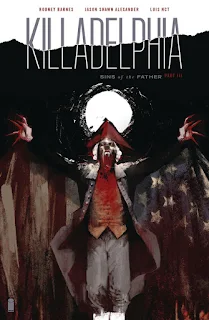KILLADELPHIA No. 6
IMAGE COMICS – @ImageComics
[This review was originally posted on Patreon.]
STORY: Rodney Barnes
ART: Jason Shawn Alexander
COLORS: Luis Nct
LETTERS: Marshall Dillon
LOGO/GRAPHIC DESIGN: Brent Ashe
EDITOR: Greg Tumbarello
COVER: Jason Shawn Alexander
VARIANT COVER ARTISTS: Jae Lee with June Chung
28pp, Colors, 3.99 U.S.(June 2020)
Rated “M/ Mature”
“Sins of the Father” Part VI: “For God and Country”
Thinking about Breonna Taylor, shot to death in her home, I think it is surreal that the Louisville police said it was the Post Office's error. I feel like Rodney Barnes and Jason Shawn Alexander are prophetic. Talent borrows. Genius steals. Prophets go where neither talent nor genius can travel.
Launched by Image Comics last year, Killadelphia is a comic book series from writer Rodney Barnes and artist Jason Shawn Alexander. The series focuses on a police officer caught in a lurid conspiracy, and its mastermind is the second president of the United States. John Adams is a vampire, and he has made the corrupt, but historical city of Philadelphia vampire-ridden. Colorist Luis Nct and letterer Marshall Dillon complete Killadelphia's creative team.
James “Jim” Sangster, Jr. is a Baltimore Police Department beat cop who comes home to Philly to deal with the final affairs of his recently murdered father, revered Philadelphia homicide detective, James Sangster, Sr. Jimmy hated his father, but daddy is not dead; he is of the undead. Now, the son, the vampire father, the chief medical examiner (Jose Padilla), and a rebellious vampire (Tevin “See Saw” Thompkins) are working to save “the City of Brotherly Love” from a vampire apocalypse and from its other hellish trials and tribulations.
Killadelphia #6 (“For God and Country”) opens as Jimmy Sr. gathers an army of law enforcement and first responders to ignite a disco inferno – Philly soul style – to stop the vampires from completing their takeover. But the main event is when Jimmy and Tevin confront the founding father of this vampire nation, and someone will die – for real this time. Meanwhile, it's “ladies first,” when a new conspiracy begins.
THE LOWDOWN: In my review of Killadelphia #5, I wrote the following:
I believe that each society, even humanity as a whole, will get the apocalypse it deserves and it earns. “You reap what you sow” ends up being more than just wisdom and being words from a religious text. Were America to fall in a vampire, zombie, and monster-driven apocalypse, the nation would finally be harvesting its fated bumper crop, the bountiful yield of its plantation state.
As I write this review of Killadelphia #6, it is the morning that George Floyd will be laid to rest. If you don't know who George is, I've already shaken off the dust of my feet. Because George has to rest in peace, a lot of Americans can't be at peace. Killadelphia #6 deftly and philosophically debates “Black Liberation” and emancipation in all their thematic glories – from oppression and revenge to mercy and uplift.
Rodney Barnes, a hugely imaginative comic book writer (who also writes for television), and Jason Shawn Alexander (Empty Zone), a fiery comic book and graphic artist, already created one of the best vampire comic books ever. But that wasn't enough for these two muthas. To say that Killadelphia is timely, while its conception likely began a year before George Floyd's killing, is to also understand that sometimes crafty storytellers are just plugged into something.
So, yeah, we are getting more than just a vampire comic book. Fries do indeed go with that Killadelphia shake. And also, I want to shout out, real loud, colorist Luis Nct's superb work on this issue and on this series overall. His name will soon be synonymous with the phrase “nightmarish colors.” Marshall Dillon still keeps Dodge City and Philadelphia under control with his lettering.
For your information: the first Killadelphia trade paperback collection (collecting issues #1 to 6), entitled Killadelphia, Volume 1: Sins of the Father, is scheduled to arrive in comic book shops and bookstores July 2020.
I READS YOU RECOMMENDS: Fans of vampire comic books will find that Killadelphia is an essential read.
10 out of 10
Reviewed by Leroy Douresseaux a.k.a. "I Reads You"
The text is copyright © 2020 Leroy Douresseaux. All Rights Reserved. Contact this blog or site for reprint and syndication rights and fees.
---------------------------------
Amazon wants me to inform you that the link below is a PAID AD, but I technically only get paid (eventually) if you click on the ad below AND buy something(s).

















